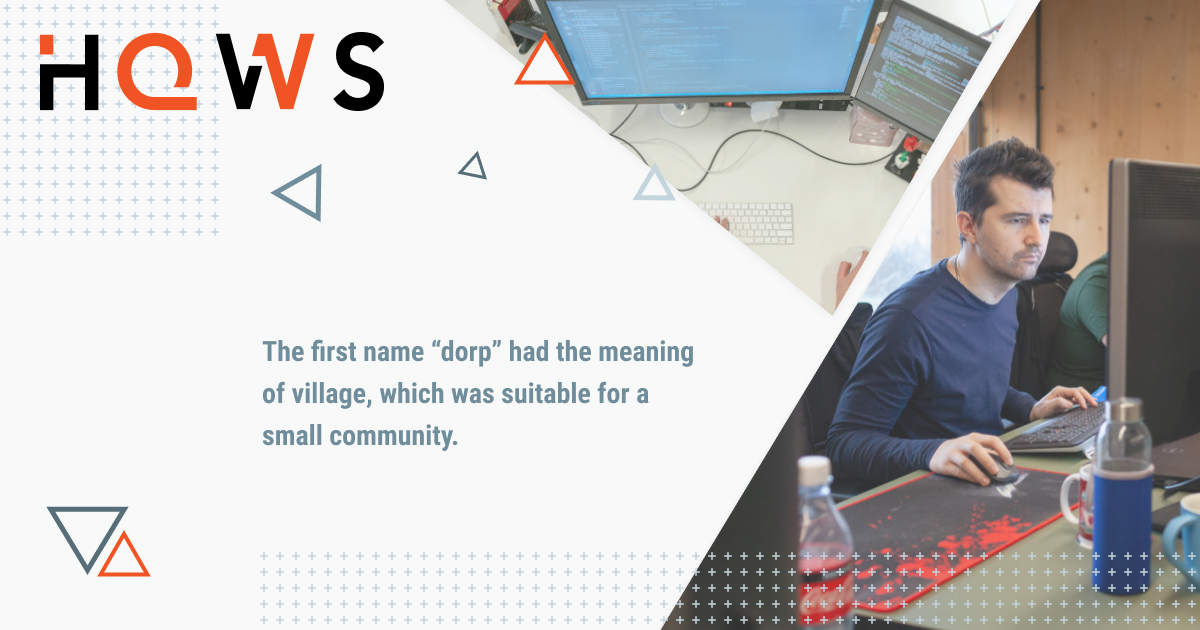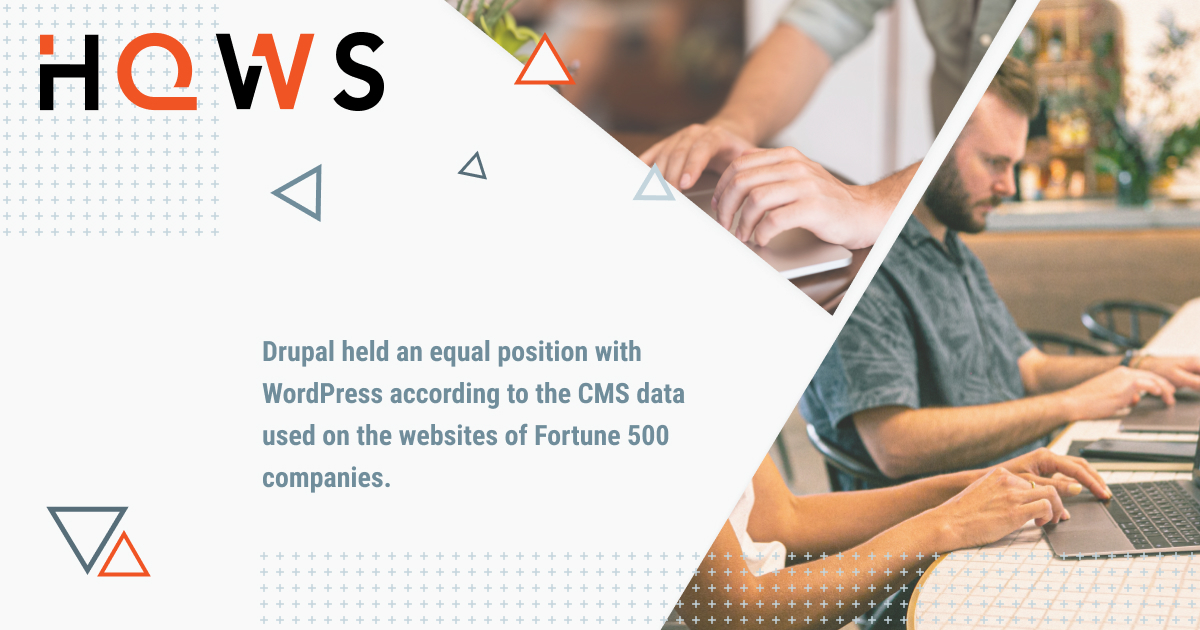Drupal: a content management system for everyone?
Introduction
Drupal is a free and open-source content management system (CMS) that is used by millions of people around the world. It is a powerful and versatile platform that can be used to create a wide variety of websites, from simple blogs to complex e-commerce stores.

Drupal CMS is known for its flexibility, security, and ease of use. It is a highly customizable platform, and thousands of Drupal modules and Drupal themes are available to extend its functionality. Drupal is also a very secure platform, and it is regularly updated with security patches.
Drupal CMS is a great choice for anyone who wants to create a website that is both powerful and easy to use. It is a good choice for businesses, organizations, and individuals of all levels of technical expertise. We present to you a description from the Drupal developer from High Quality Web Solutions.
What is Drupal?
The name Drupal did not appear just like that, but it did not have any connection to technology in its name and had a funny history of its appearance. Dries Buytaert, web developer and the founder of Drupal is from Antwerp in Belgium, and in 2000 he and several students at his university used an ADSL modem to access the Internet, which at the time had problems with access. By creating wireless bridges between dormitories, Dries made a website for this small network to communicate with friends. Initially, this site did not have a name, but when the training ended, it was decided to leave a "web board" for further communication. So it was decided to place the site on the network. The first name dorp had the meaning of village, which was suitable for a small community. But when registering dorp.org, an error was made and the site became drop.org. After its appearance, the new site attracted new users and became a place for discussing web technologies. In 2001, it was decided to launch software allowing developers to use and improve the new platform. It is then that the familiar name Drupal appears as a derivative of ‘droo-puhl’, from the English pronunciation of the Dutch word ‘druppel’, which means "drop".

Since then, development has moved to drupal.org, which is now the project's official website. In 2003, Drupal became a prominent solution for the political campaign of one of the candidates in the primaries of the US Democratic Party and was used to support the decentralized network of websites of one of the candidates. After that, web specialists working on the project became the first to provide development services on Drupal. There are also many new web development companies providing Drupal development services.
Why Drupal is used?
The architecture of Drupal allows you to use it to create websites of different orientations - from blogs to information archives. A large number of additional options help to expand the functionality of the website for any project.

Drupal out of the box has great features:
- unified categorization of all types of content (taxonomy)
- a wide set of properties when building rubrics: flat lists, hierarchies, hierarchies with common ancestors, synonyms, family categories
- nesting of categories of any depth
- search by site content, including search by taxonomy and users
- delineation of user access to materials (role model)
- dynamic menu construction
- support for XML formats: the output of documents in RDF / RSS, aggregation of materials from other sites
- BlogAPI for publishing materials using external programs
- authorization via OpenID
- symbolic meaningful URLs.
- translations of the site interface in different languages, as well as support for maintaining multilingual content
- the ability to create sites with overlapping content (for example, a common user base or common settings)
- separate site configurations for different virtual hosts (multisite), including their own sets of modules and design themes for each subsite
- notification of outgoing module updates

Drupal is written in PHP, a popular programming language. It is based on the Symfony framework, a powerful and flexible PHP framework.
More about Drupal Features
Taxonomy
Organizing website content into different categories can be done through the use of taxonomy. This tool allows for the creation of multiple thematic categories that can be associated with different modules to manage information input and output. Categories can be arranged in a flat or hierarchical structure, and elements can have multiple parents and children. This makes it easy to structure content in a variety of ways using the same Drupal modules. For instance, creating a comprehensive list of keywords for all site documents is simple with this tool.
Another approach to organizing website content is through the Content Construction Kit (CCK) extension in Drupal. This allows for the addition of new fields of various types, such as URL and email input fields, and areas for multimedia files. Additional CCK modules, like Node reference, can also establish links between documents without relying on the taxonomy mechanism.

Localization
The platform allows for the interface to be translated into over 100 languages, but some translations may not be fully complete. Drupal CMS uses its own method for localization, saving translations in the database alongside other site content. Site translations can be imported and exported in po-file format, which is used by the ‘gettext’ library. To achieve full content localization, third-party modules can be downloaded from the developers' site as they are not included with Drupal.
Database abstraction
Before Drupal 7 functions handled database tasks, including cleaning SQL queries, adding prefixes to multi-site table names, and creating accurate SQL queries. With the introduction of Drupal 6, an abstraction layer was implemented, enabling developers to write SQL queries without the need to write actual SQL code.
Through the expansion of the data abstraction layer with Drupal 9, programmers no longer have to manually write SQL queries as text strings. This is achieved through the use of PHP Data Objects, which abstract the database. Additionally, Microsoft has developed a database driver for their SQL Server. For web developers using Drupal 7, support for the file-based SQLite database engine, which is included in the standard PHP distribution, is available.
Drupal Benefits
Here are some of the benefits of using Drupal CMS:

- Free and open source: Drupal is free to download and use, and the source code is available for anyone to view and modify.
- Flexible and customizable: Drupal is a very flexible platform, and there are thousands of modules and themes available to extend its functionality. At the moment, more than 50,000 Drupal modules for any task are listed on the project's official website. The number of available topics today is more than 3,000 according to the same resource. Our Drupal developers have created a series of posts describing the most used Drupal modules in 2023.
- Secure: With robust architecture and a dedicated security team, and constant updates, Drupal is a very secure platform, and it is regularly updated with security patches.
- Community: There are over 1 million accounts registered on drupal.org, which includes 30,000 developer accounts.
Who is used Drupal?
Drupal is used by a wide range of organizations in different industries. It is popular for its security, scalability, and customizability.
Government: Government agencies use Drupal CMS to develop secure and scalable websites capable of handling high traffic volumes. The United States Department of State, for instance, relies on Drupal to power its website, which attracts millions of visitors annually.
Nonprofit: Nonprofit organizations utilize Drupal to design websites that are user-friendly and simple to handle. These organizations frequently require modifications to their websites to cater to their distinct audience, and Drupal simplifies this process.
Education: Many educational institutions rely on Drupal to create engaging and informative websites. This platform can be used to build a range of educational sites, from basic course management systems to sophisticated learning management systems. Harvard University is a great example of this, as it uses Drupal to power its website, which showcases information about courses, faculty, and campus life for students.
Media and publishing: Media companies rely on Drupal to create dynamic and engaging websites. With Drupal, it's possible to build a diverse range of media sites, including news websites, blogs, and online magazines.
E-commerce: Online stores utilize Drupal to develop secure and scalable websites capable of handling high volumes of transactions. Drupal is versatile in creating diverse e-commerce websites, ranging from small businesses to large retailers.

Here is a short list of popular websites using Drupal for today:
- NASA
- The City Of London
- Tesla
- Box
- Verizon
- Nokia
- McDonald’s Australia
- Harvard University
- Stanford University
- The Emmy Awards
- Oscar
- Natural History Museum of Los Angeles
Drupal or WordPress
Today, WordPress has the status of a leader among all CMS in the world, so let's compare Drupal with this project.
Ease of use. Drupal is more complex to set up and use than WordPress. It requires more technical knowledge and experience. WordPress is easier to set up and use than Drupal. It is a good choice for beginners and those who do not have a lot of technical knowledge.
Customization. Drupal is more customizable than WordPress. A wider range of Drupal modules and themes can be used to change the look and functionality of a website. WordPress is less customizable than Drupal. However, there is still a wide range of modules and themes that can be used to change the look and functionality of a website.
Security. Drupal is a more secure CMS than WordPress. It has a number of security features built-in, and it is regularly updated with security patches. WordPress is less secure than Drupal. However, it is still a secure CMS, and it is regularly updated with security patches.
Scalability. Drupal is more scalable than WordPress. It can handle a higher volume of traffic and a larger number of users than WordPress. WordPress is less scalable than Drupal. However, it can still handle a high volume of traffic and a large number of users.
Community support. Drupal has a large and active community of users and developers. This means that there is a lot of support available for Drupal users, and there is a wide range of resources available online. WordPress has a larger and more active community of users and developers than Drupal. This means that there is even more support available for WordPress users, and there are even more resources available online.

Drupal Pros
- Highly customizable
- Secure
- Scalable
- Large and active community
Drupal Cons
- More complex to set up and use
- Requires more technical knowledge
WordPress Pros
- Easy to use
- Large and active community
- Wide range of themes and plugins
WordPress Cons
- Less customizable
- Less secure
- Not as scalable as Drupal
A comparison of Drupal vs WordPress shows that for complex, scalable projects, it is Drupal that has more necessary tools for creating a reliable website. Last year our Drupal developers with a post about CMS statistics for 2022 showed that Drupal held an equal position with WordPress according to the CMS data used on the websites of Fortune 500 companies.

Drupal 7 EOL
Final date! Drupal 7 EOL on January 5, 2025. Dries Buytaert reported about it. The deadline is fast approaching in 17 months! As a result, Drupal 7 websites will become increasingly vulnerable to security vulnerabilities.
The Drupal community recommends that users of Drupal 7 migrate to a newer version of Drupal as soon as possible. There are a number of migration tools and services available to help users migrate their Drupal 7 websites to a newer version. It's advisable to start considering the migration of your website to a newer version of Drupal. If you are a user of Drupal 7, it is important to start planning your migration as soon as possible. Our Drupal developers have provided a number of resources to help with migration, including a migration checklist and a list of migration tools and services.
The migration process is not easy and may take some time. We offer website audits from HQWS Drupal developers to provide migration recommendations.
What current version of Drupal for today?
Currently, over 1,000,000 websites in the world use Drupal in various versions. We've already noted that more than 40 percent of them are still using Drupal 7, even though that version will soon end support. So the owners of these websites should make their choice before migrating their websites. Drupal's 8 different versions rank third among versions with just over 12 percent. Second place goes to Drupal 9 with 33 percent. Drupal 9 also currently has the status of an interim version after the release of Drupal 10, the share of which is currently less than 1 percent. Yes, you read that, exactly what was meant - support for Drupal 9 will also decrease over time, and the end of life of this version is also not far away, so the future belongs to Drupal 10.
Drupal 10 is the latest version of the popular open-source content management system. It offers many new features and improvements that make it easier, faster, and more secure to build and manage websites. Some of the features of Drupal 10 are:
- A modern front-end theme based on the Olivero design system, which provides a responsive, accessible, and user-friendly interface for site visitors and editors.
- A new layout builder that allows site builders to create custom layouts for different content types and display modes, using a drag-and-drop interface and live previews.
- Media library that simplifies the management and reuse of media assets, such as images, videos, audio files, and documents.
- A new configuration management system that enables site administrators to track and synchronize configuration changes across different environments, such as development, staging, and production.
- A new update manager that helps site owners to keep their sites up-to-date with the latest security and feature updates, as well as upgrade from Drupal 8 or 9 to Drupal 10 with minimal disruption.
- Experimental web services module that allows site developers to expose data and functionality from their sites as RESTful APIs, enabling integration with other applications and services.

Not only Drupal Community
Having quite a community, Drupal developers take care of holding events aimed at improving the interaction between members of this community, holding annual DrupalCons
DrupalCon is an annual event that brings together Drupal developers, users, and enthusiasts from around the world. It is a great opportunity to learn new skills, network with peers, and discover the latest trends and innovations in the Drupal community. DrupalCon offers sessions, workshops, keynotes, sprints, and social events for all levels of experience and interest. Whether you are a beginner or an expert, a site builder or a coder, a designer or a marketer, DrupalCon has something for you.
Bottom Line
Although some web developers believe that Drupal is dead, this is not even close to reality. The Drupal community is growing, the Drupal CMS is developing steadily with updates and improvements. Even Drupal was awarded the title of Digital Public Good this year.
What are the conclusions? Drupal CMS is not needed for small projects that do not plan to scale in the future. That is, for a small blog without a significant amount of content, or for a landing page, it is better to choose a simpler CMS. But if you have an e-Сommerce project or a business portal, then it is better to make a balanced decision about choosing a system. Web developers at HQWS have extensive experience in working with this CMS and have developed a checklist for migration from Drupal 6 and Drupal 7 to updated versions. Contact our specialists if you want to get it.
